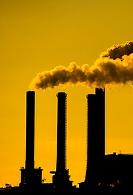 It took 10 years for the pollution load of industry to double, and then it took just three more years for this to rise by 50 per cent, says Sunil K Sinha.
It took 10 years for the pollution load of industry to double, and then it took just three more years for this to rise by 50 per cent, says Sunil K Sinha.
An important outcome of the economic liberalisation and changes in industrial policy initiated since 1991 has been industrial restructuring and reallocation of resources towards activities and sectors with a greater comparative advantage.
This has improved the productivity and efficiency of India's manufacturing sector and made it globally competitive. But does comparative advantage also mean that the sectors witnessing increased industrial activity are less or more polluting?
If you look at Annual Survey of Industry (ASI) data along with the Industrial Pollution Projection System (IPPS) method developed by the World Bank, this suggests that in the post-reforms period, the share of 'more polluting' industries in total manufacturing sector has gone up ('more polluting' includes paper, chemical, rubber and basic metals production - see table for list of industries in various polluting categories). And this is true on all the three parameters selected, namely employment, value of output and value added.
In 2005-06, the share of 'more polluting' firms declined marginally when it came to employment - while 39.5 per cent of those employed in the entire manufacturing sector in 2002-03 were in the 'more polluting' industry, this fell to 38.6 per cent in 2005-06.
This marginal decline, however, did not take place when you look at the share of the 'more polluting' industry in overall manufacturing output or even value added (see table).
The share of 'less polluting' industry (wood and wood products, for instance) rose but given its very low share (3.7 per cent in terms of overall manufacturing sector output), this hasn't helped much.
It is difficult, on the basis of the ASI data, to say whether industrial policy pursued since 1991 has had a bias in favour of 'more polluting' industry, but the structural shift in the relative share of the type of industry in total manufacturing indicates that 'more polluting' industries have expanded much faster than 'somewhat polluting' industries between 1990-91 and 2005-06.
When environment policies are weak, more polluting industries tend to come up in developing countries - is this happening in India as well?
The Industrial Entrepreneurs Memorandum (IEM) filed with Department of Industrial Policy and Promotion suggest this is the case. The share of 'more polluting' industry in the total IEM's filed since 1991 increased from 53 per cent in 1998 to 54 per cent in 2002 and further to 56 per cent in 2005. It is only after 2005 that their share in total IEMs declined a bit.
|
READ THE SMOKE SIGNALS | |||||||||
|
|
No of Persons Engaged |
Value of Output |
Value Added | ||||||
|
1990-91 |
2002-03 |
2005-06 |
1990-91 |
2002-03 |
2005-06 |
1990-91 |
2002-03 |
2005-06 | |
|
More Polluting Industries* |
30.43 |
39.48 |
38.64 |
52.09 |
56.49 |
59.64 |
54.34 |
62.65 |
64.55 |
|
Somewhat Polluting Industries# |
67.34 |
57.63 |
57.93 |
46.62 |
40.73 |
36.65 |
44.17 |
34.90 |
32.71 |
|
Less Polluting Industries |
2.22 |
2.88 |
3.44 |
1.30 |
2.77 |
3.71 |
1.49 |
2.45 |
2.74 |
|
Total |
100.00 |
100.00 |
100.00 |
100.00 |
100.00 |
100.00 |
100.00 |
100.00 |
100.00 |
|
* 'More polluting industries' include paper, chenmicals, rubber, coal, petroleum, metal/non-metal industries; # 'Somewhat polluting industries' include food and beverages, leather, machinery and equipment and transportation eqipment. | |||||||||
Another way to look at industrial pollution is to apply an innovative method pioneered by the World Bank where environmental data is generally not available. Based on extensive data available for USA, a ratio of emissions per unit of manufacturing activity was found and the World Bank calls this Industrial Pollution Intensity Index - the method itself is called the Industrial Pollution Projection System (IPPS).
It is obvious that there will be country-specific differences but the pattern of sectoral intensity rankings is likely to be similar.
Our calculation shows that air, land and water pollution load of the manufacturing sector as whole in 2005-06 has increased considerably as compared to 1990-91.
For air pollution, the load rose from 2,108 tonnes in 1990-91 to 4,143 tonnes in 2002-03 and to 6,052 tonnes in 2005-06; for land pollution, the figures rose from 4,498 tonnes to 8,887 tonnes to 12,921 tonnes; for water pollution, the figures were 429, 926 and 1,239 tonnes respectively.
That is, the pollution load of the manufacturing sector on all three counts (air, land and water) around doubled between 1990-91 and 2002-03 and then rose another 50 per cent after that.
While it took more than 10 years for the pollution load to double from the 1990-91 level, it took only three more years for it to triple from the 1990-91 level.
Although industries belonging to the 'more polluting' segment emit more pollution per unit of output, their overall contribution to environmental pollution will depend upon their size in manufacturing activity.
For example, though non-metallic mineral products belong to the category of 'more polluting' industries, their overall contribution in total air pollution load in 1990-91 was around 1.2 per cent of the total - this has remained around the same ever since.
On the other hand, though textiles belong to the category of 'somewhat polluting' industries, their contribution in total air pollution load was 10.6 per cent in 1990-91, 7.7 per cent in 2002-03 and 6.8 per cent in 2005-06.
Moreover, the four largest polluting sectors (chemicals and chemical products, rubber, petroleum and coal products, basic metals and textiles) contributed around 88 per cent of total air pollution in 2005-06 and 91 per cent of the land pollution load.
An implication of this is that a substantial reduction in total pollution loads can be achieved by actually focusing pollution control efforts on a limited number of industrial sectors.
Although a number of factors influence the growth and spread of industrial activity, industrial policy plays an important role. To the extent it reduces economic distortions and promotes economic efficiency by bringing in reallocation of resources and improving industrial efficiency, such policies are good for the environment.
However, in the presence of unaddressed market failures and/or policy distortions, the reallocation of resources and increased industrial activity may actually aggravate environmental problems.
Thus a policy programme that seeks to promote both industrial growth and environmental protection is always more attractive. Unfortunately, this is not the case in India.
The author is Head and Senior Economist at Crisil Ltd. The views expressed are personal.











 © 2025
© 2025